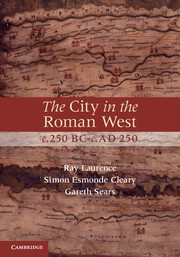Book contents
- Frontmatter
- Contents
- Illustrations
- Preface
- Introduction
- 1 The creation of an urban culture
- 2 Colonisation and the development of Roman urbanism
- 3 City foundation, government and urbanism
- 4 The reception of Roman urbanism in the West
- 5 Town planning, competition and the aesthetics of urbanism
- 6 Defining a new town: walls, streets and temples
- 7 Assembling the city 1: forum and basilica
- 8 Assembling the city 2: baths and urban life
- 9 Assembling the city 3: theatres and sacred space
- 10 Assembling the city 4: amphitheatres
- 11 The Roman city in c. AD 250: an urban legacy of empire?
- Bibliography
- Index
10 - Assembling the city 4: amphitheatres
Published online by Cambridge University Press: 05 June 2012
- Frontmatter
- Contents
- Illustrations
- Preface
- Introduction
- 1 The creation of an urban culture
- 2 Colonisation and the development of Roman urbanism
- 3 City foundation, government and urbanism
- 4 The reception of Roman urbanism in the West
- 5 Town planning, competition and the aesthetics of urbanism
- 6 Defining a new town: walls, streets and temples
- 7 Assembling the city 1: forum and basilica
- 8 Assembling the city 2: baths and urban life
- 9 Assembling the city 3: theatres and sacred space
- 10 Assembling the city 4: amphitheatres
- 11 The Roman city in c. AD 250: an urban legacy of empire?
- Bibliography
- Index
Summary
The games in the amphitheatre, whether beast hunts or gladiatorial contests or both, have become the iconic feature of Roman culture. This is true not just in popular culture, whether in film or on television, but also in academic scholarship. Keith Hopkins did much to elucidate a vision of Roman culture that was defined by means of the gladiatorial games in the amphitheatre (fig. 10.1). However, we need to remember at the outset that at Rome there was no stone amphitheatre until 29 BC, when Statilius Taurus constructed one in the Campus Martius (later destroyed in the fire of AD 64), and it was only surpassed by the building of the Colosseum, which was opened by the Emperor Titus in AD 80 – a structure that would remain the largest amphitheatre in the Roman world. It was not in Rome that the stone-built amphitheatre was developed, but in the cities of Italy that contained veterans. We need to look first at the cities of Italy to understand the presence of the amphitheatre in the Roman city, what this new structure meant and when it was adopted as a desirable addition to the fabric of these cities. From there we will examine the rather patchy adoption of the amphitheatre in the western provinces (fig. 10.2). It will also be important to consider the amphitheatre as an expression of Romanness. Did an amphitheatre make a city more Roman? Did the new monumental form developed in the cities of Italy give a distinctively Roman character to the cities of the West that was absent in the cities of the Greek world?
- Type
- Chapter
- Information
- The City in the Roman West, c.250 BC–c.AD 250 , pp. 259 - 284Publisher: Cambridge University PressPrint publication year: 2011

